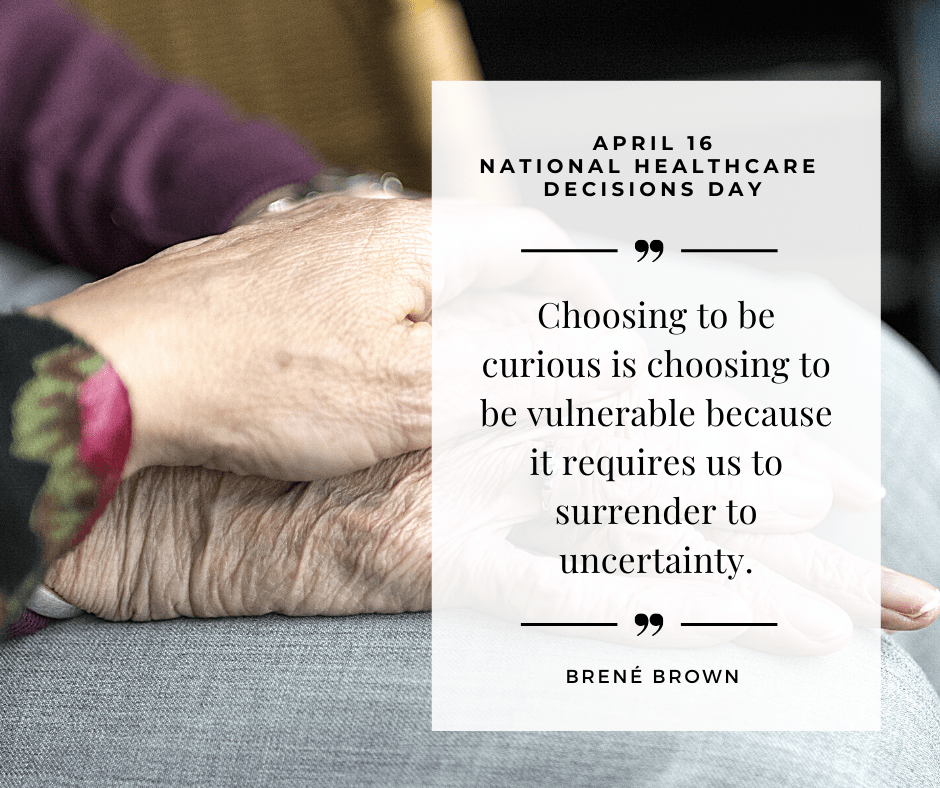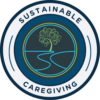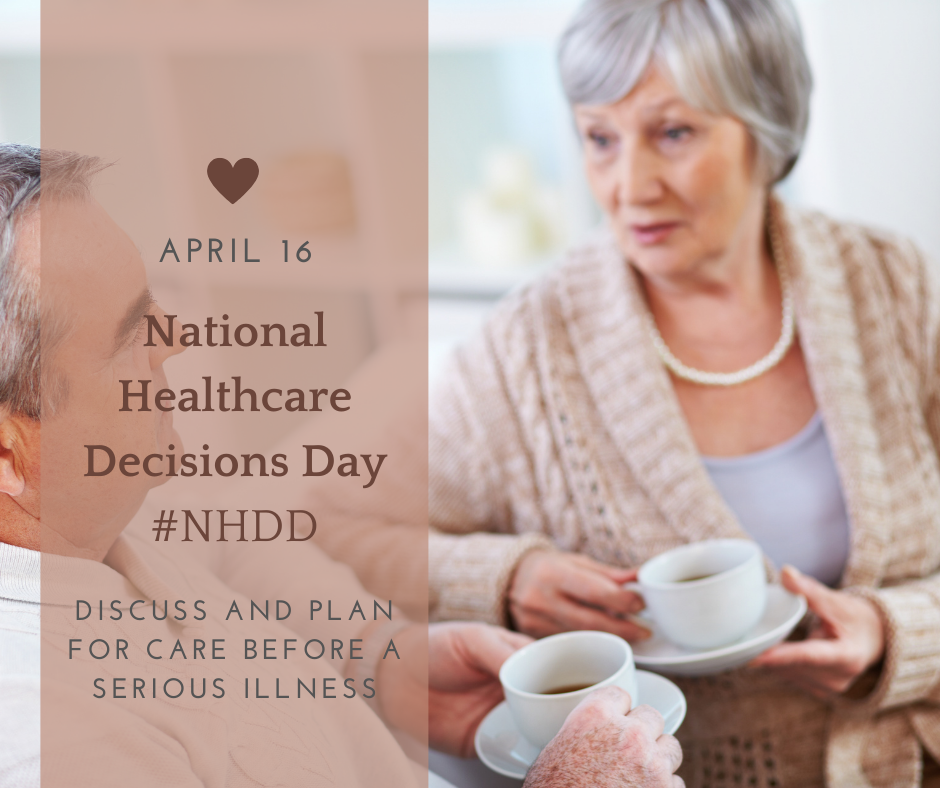“A person’s success in life can usually be measured by the number of uncomfortable conversations he or she is willing to have.”
Timothy Ferriss
National Healthcare Decisions Day (NHDD) is April 16! NHDD focuses on vital end-of-life decisions. It is critical to have these discussions before an illness or accident because a plan to wait until a crisis arrives on the doorstep is not a plan. Collaboration is key. Co-create the vision. Have the sustainable aging and end-of-life discussions before you are enveloped in the emotions that accompany a crisis. April, springtime, is the perfect season to begin preparing for the winter. Give the gift of a good death to all of those in your circles by encouraging end-of-life conversations.
The reality is that many other meaningful conversations help prepare our family members and ourselves for aging in a way that is sustainable for the entire family. It is not important who initiates this dialogue, and each conversation is not a one-and-done event but a series of discussions that evolve as circumstances and wishes change. Open, honest communication is crucial to create a sustainable foundation for collaboration between current or future caregivers and the family members who will receive support. Curiosity and vulnerability are two essential strategies that will help you explore all aspects of these sensitive topics.
Prepare for aging-related and end-of-life conversations
Begin with the end in mind
When we begin with the end in mind, we acknowledge the reality that all of us are on a journey with a common destination. The decisions surrounding end-of-life are something most of us will confront, and when we explore wishes with those closest to us, we are demonstrating love and care. End-of-life conversations may be initially uncomfortable and cause us to feel vulnerable but in the end, empower us and our family members to decide how we want to live and how we want to die.
Curiosity and vulnerability
When we approach sustainable aging and end-of-life conversations by demonstrating our own vulnerability, we create a safe space for family members to express their feelings and emotions. Acknowledge that the subject is unsettling and uncomfortable to discuss. Being vulnerable takes courage. Having these conversations takes courage. Sit with the discomfort and then lean into it. Explore your fears.

Curiosity about your thoughts surrounding your aging and end-of-life will help you begin the conversation with others. You may be surprised to find that your reflection on death brought you to an entirely different place than that of your family member. The most important outcome, especially in the early discussions, is to keep communication lines open.
Research the options and locate the resources
When you have an understanding of the components that will be a part of the conversations, you can decide the order and depth as you progress.
Meet resistance with patience
When you begin the process of creating a safe space for open dialogue, it is not uncommon to start the conversation and be met with resistance. When met with a refusal to continue the discussion, table it and revisit the subject later. You may make a small amount of headway during each attempt until you achieve a breakthrough.
Here are five conversations that will help you create a sustainable foundation of care.
End-of-Life Planning
Considerations
Learn the terms and understand the components surrounding end-of-life decisions. Advance directives are a good place to start because of the importance of understanding your family member’s wishes and ensuring that a person is designated to support and communicate those wishes if required.
Helpful Tools
Spend time reviewing the tools offered by The Conversation Project. The conversation starter kit will prompt you to explore your thoughts on end-of-life to prepare you for the conversation with your family member. You will find ice breakers, questions, and tips that will help you manage the conversation. Consider ordering The Five Wishes. It is an advance directive document that is easy to use and will help guide the conversation. With witness signatures, it is legally valid in 42 states. Gain a better understanding of palliative care and end-of-life doula services. Knowledge is power. Researching these resources will provide information that will add value to your conversation.
Consult with an Elder Law Attorney
Some attorneys specialize in elder law. The National Academy of Elder Law Attorneys offers a directory and information on the advantages of selecting an attorney who regularly manages your particular concerns. Not all Elder Law attorneys specialize in every field of Elder Law. It is recommended that you locate an attorney whose focus matches your situation. As with all professional services, referrals and recommendations are an excellent place to start on your quest to find the right fit.
How to Get Started
You may begin the conversation by asking your family member if there is a Durable POA or a Healthcare POA already in place. Suppose a health care representative has not been designated. In that case, it is an essential first step to ensure that your family members’ decisions are upheld if they cannot share their preferences. It is a good practice to review this document annually to ensure that no changes are desired.
You might share that you have been thinking about your own future and share thoughts on your wishes. Then, ask open-ended questions. When we are curious and seek to understand, we can avoid assumptions. The Five Wishes document is a great place to begin the process of documenting your family member’s choices.
Talking points
- Do you have a Durable POA or a Health Care POA?
- Is your attorney familiar with elder law issues?
- May I meet your attorney?
- Do you have a living will?
- What are your end-of-life wishes?
- Have you made funeral and burial plans?
- Where is the legal paperwork kept?

Financial
Considerations
Conversations about finances are crucial for many reasons. Many family members first notice signs of a family member’s dementia in the bank account. Also, older adults are vulnerable to fraud.
Due to the subject’s sensitive nature, it may take years of conversation to reach a place of collaboration. If legal steps are required, it is best and less expensive to manage the process before a crisis. A dementia diagnosis can reduce the options. The most important place to start is to simply know where financial documents are kept. The next step may be to monitor accounts.
At some point, more oversight will be needed. Begin the conversations, and don’t be discouraged by rejection. Occasionally, revisit the subject with empathy and openness.
Talking Points
- Do you have a financial advisor?
- What plans have been made that you can share?
- Could we set up a meeting so that I may meet him/her?
- Where do you bank?
- What insurance policies do you have?
- Where are the documents and the contact information for banks, brokers, and insurance information kept?

Health
Considerations
A hospitalization or disease diagnosis can be the first time many family members know a parent’s health and medical details. Suddenly, there is a lot to learn and with a rapidity that is ripe for errors. It is important to know that mistakes and misunderstandings are inevitable in these situations regardless of how well we have prepared. Forgiveness and compassion are important components of a sustainable caregiving experience.
Learn about your family member’s current health and medical condition before a crisis. It will reduce the learning curve. Learning the details in advance will help you participate more confidently, ask questions and collaborate on decisions to advocate for your family member.
Talking Points
- Would you be willing to share a list of your current healthcare providers?
- How do you like your PCP? May I meet him or her?
- Who are your other key doctors? What is your relationship like with them?
- How do you manage your medications? Do you have a medications list?
- May I have a copy?
- Have you thought about alternative ways to manage medications?


- How do you think a disease diagnosis or hospitalization might change your situation?
- Would you consider starting a health care journal to keep all of this information and to document visits?
- Maintaining good health will help you to continue to keep your options open. How are you staying fit?
- In what ways are you eating healthy?
- Are you happy with the amount of time you spend with friends, on hobbies and interests?
Home
Considerations
We often don’t think about where we would like to live in 10 or 20 years and what accommodations may be needed to support our lifestyle and abilities. Conversations about where and how a family member envisions their future home are essential because the desires and choices impact the entire family. Will our family member want to be closer to family, and if so, which family members? Is the current home suitable for aging in place, or will modifications be required? When decisions are made under duress, it is emotional. Collaboration is often discarded when all family member’s positions are rooted in fear. The fears that drive the discussions are directly in competition for control. For these reasons, have the conversations sooner rather than later. The Senior Moving Guide: Storage and Housing Assistance is a terrific tool that provides guidance on the complexities of downsizing and moving and great talking points to get the conversation started.
A daughter, for years, assumed that she would move in with her mom when her mom began to need more assistance. Her siblings worked off the same assumption, but there had never been a conversation with Mom. Recently, her mom said that that was never going to happen. It was a wake-up call. My friend’s mom was going through treatments and had significant health considerations. The conversation was overdue.
Another daughter received a call from her mom. Mom said, “Your dad and I want to know if you want us to put a deposit on a retirement home here in Florida or closer to you in Tennessee?” That simple question ticked off many talking points and opened up communication channels for a more in-depth discussion.
Talking Points
- Where do you see yourself, or what would be your ideal living situation in 10 years?
- How will your financial situation support your plan?
- Have you thought about creating age-friendly spaces or downsizing?
- How do you imagine family will be involved in your future?

What if
- Using the “what if’s” for planning
- What is the worst that could happen?
- What is the best possible outcome?
- Discuss what options are possibilities for each of these outcomes.
Plan B
- What will it look like when the family begins to help out?
- Have you considered what it might be like to have someone helping out with chores?
- If you had to create a résumé of the ideal person to assist you, what characteristics would you envision for the person you hire?
- What would the ideal schedule look like?
- There are many meal service agencies. Have you tried any of them?
- Would you like to take a look at grocery delivery?
- Home care agencies offer help with housekeeping and meals. Are you familiar with any in the area?
- Have you toured any retirement communities?
- There are alternatives to driving. Would you be interested in trying any of them for more extended or nighttime drives?
Plan C
- If you are no longer able to live on your own
- Is it realistic to consider moving into a family member’s home?
- Or, is a retirement home a better option?
Legacy
Considerations
David Solie tells us that, “Whether they express it or not, life review is the dominant psychological event of getting old… Senior adults focus on reviewing their lives to find what it meant for them to have lived.” He makes clear that this is the primary concern, following control, over an older adult’s present and future. An important part of our role is to help our family members process their life stories in a way that helps them discover the meaning that will continue when they are no longer here. We can only fulfill this important task if we are not in a battle for control over legal, financial, or independence matters.
Talking points
In conversation
- Ask open-ended questions300 Questions to Ask Your Parents Before It’s Too Late, by Shannon Alder
- Conversation Starters: 20 Questions to Ask Your Elderly Parents
- “Tell me about…” is a powerful prompt
- Use active listening skills
- Focus on values or themes
- Listen for new detail in frequently repeated stories and explore the meaning

Written or recorded form
- Consider documenting your life story and events that shaped who you are.
- This record will become an amazing gift.
- How can you capture and share these events and lessons?
- Written
- Photos
- Video
- Combinations
Communication Tips
Considerations
How to have sustainable aging and end-of-life conversations is arguably more important than what to say during the discussions. It is essential to be clear on your objectives before beginning. Set an intention. Understand that the ultimate goal is to keep the channels of communication open. This is not a one-and-done conversation. Getting to win/win requires that you maximize empathy and minimize ego. Be curious.
Talking Points
- I’ve been thinking about my future and realized that we haven’t talked about your plans.
- I saw this article on aging in place, and I wondered if that was something you wanted to discuss.
- What are your plans for the future? How can I best help you manage your plan?
Memento Mori
The stoics recommended confronting death daily. Memento Mori may seem morbid but is a powerful reminder to live each day according to our values. It is a reminder that if we don’t take charge of what is important in our present and our future, then life will happen to us rather than us navigate the process with confidence.
“Let us prepare our minds as if we’d come to the very end of life. Let us postpone nothing. Let us balance life’s books each day. … The one who puts the finishing touches on their life each day is never short of time.”
Seneca
Navigating the Caregiver River: A Journey to Sustainable Caregiving is available on Amazon. Also, check out the Self-Caregiving Strategies Podcast.
Schedule Theresa Wilbanks to speak on caregiving and empower the caregivers in your workplace or community with the 12 Sustainable Caregiving Strategies.
Advice offered is for general information only; please contact your healthcare team, legal or financial advisors to guide your particular situation.


Pingback: Timing Transitions: Reading the Caregiver River - Sustainable Caregiving™